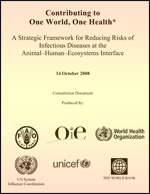|
Contributing to One World, One Health*A Strategic Framework for Reducing Risks of Infectious Diseases at the Animal-Human-Ecosystems InterfaceProduced by Download full PDF |
Table of contents
Abbreviations and acronyms
Executive summary
1. Introduction: HPAI and beyond
2. Achievements and lessons learned from HPAI and their relevance to EID
2.1 Current status
2.2 Achievements of the ongoing HPAI response
2.3 Lessons learned
3. Emerging and existing infectious diseases and their impacts
4. The Strategic Framework
4.1 Goal
4.2 Overall objective
4.3 OWOH perspective and its relevance to this Strategic Framework
4.4 Guiding principles
4.5 Prioritization
4.6 Burden of disease, benefit-cost analysis and and costing strategies
4.7 The public-private good dimension at different levels
4.8 Role of international agencies in addressing global public goods
4.9 Building on existing institutions and their unique strengths
5. Specific objectives and outputs
5.1 Develop surveillance capacity, including the development of standards, tools and monitoring processes at natioanl, regional and global levels
5.2 Strengthen public and animal health capacity, including communication strategies to prevent, detect and respond to disease outbreaks at national, regional and international levels
5.3 Strengthen national emergency response capability, including a global rapid response support capacity
5.4 Promote inter-agency and cross-sectoral collaboration and partnerships
5.5 Control HPAI and other existing and potentially re-emerging infectious diseases
5.6 Conduct strategic research
6. Cross-cutting issues to be addressed
6.1 Surveillance and disease intelligence at the three health domains
6.2 The need to improve biosecurity
6.3 Bioterrorism
6.4 Mechanisms to address socio-economic disincentives
6.5 The need to address broader development issues
6.6 Communication strategies at different levels
6.7 Private-public partnership
6.8 Monitoring and evaluation
7. Institutional issues
7.1 Guiding principles and characteristics of a successful network
7.2 Institutional coordination and collaboration
8. Financing the framework
8.1 Shifting the paradigm: Broad the avian and pandemic influenza response
8.2 Global public goods and international commitment
8.3 Responding to the AHI threat: An unfinished agenda
8.4 Capacity building for prevention: A results-based approach
8.5 Contingency funding for the unknown
8.6 Source of funds
8.7 Existing initiatives
8.8 Moving forward
Annexes
1. The Manhattan Principles on "One World, One Health"
2. Advantages and challenges to an OWOH approach
3. List of diseases of common interest
4. International technical agencies, collaboration and new mechanisms
5. Indicative research topics
6. Basic assumptions used to assess the Strategic Framework's financing requirements
7. References
8. Web links
* The ‘One World, One Health’ concept, which establishes a more interdisciplinary and cross-sectoral approach to preventing epidemic or epizootic disease and for maintaining ecosystem integrity, is a trademark of the Wildlife Conservation Society.
